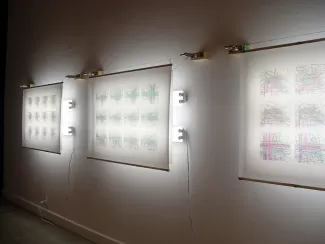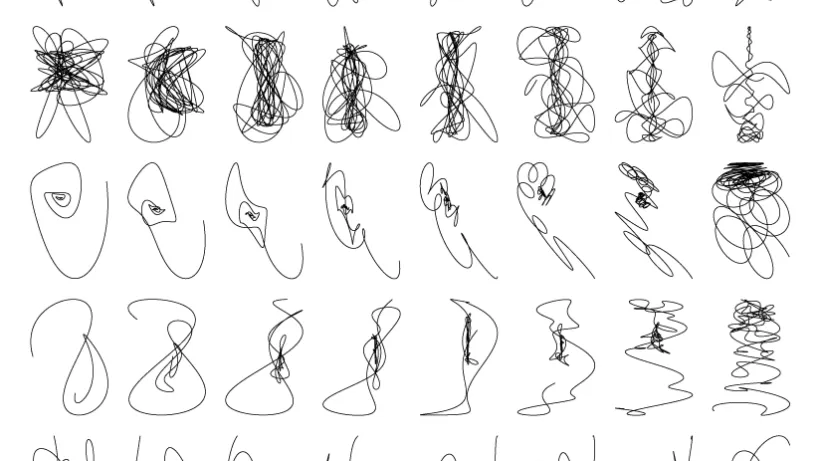This work explores the possibilities within a single system for creating random highly variable curves based on a harmonograph simulation. The harmonograph was a popular scientific toy of the late 19th century (lately making a comeback in contemporary science museums) which drew complicated Lissajous figures by attaching a pen to a multidimensional pendulum.
The simulation of these curves use parametric equations that are a complex concatenation of basic sin waves with the general formula:
x = a*sin(ft+p) + ...
y = a*sin(ft+p) + ...
where a is amplitude, f is frequency, p is phase.
Here, the most basic drawing of a curve at random is demonstrated:
harmono_curve.js
- click for new harmonograph
Stragies for animation derive from a the interpolation between random instances of the curve:
harmono_oo.js
- click to reset to new harmonograph

Work in this series take these basic forms as a starting point. What I found is that the play of the curves tends to escape from their simply formal aspect. Attention is drawn to the nature of systematicity: the relation between system and instantiation, the tension between possibility and constraint, and a metaphoricity which brings us to the allegorical significance of the abstract.
The figures created by these systems have a legible character: personality, mood. They sometimes suggest the creativity of the human hand. But they seldom fail to betray their mechanical origin.
While working on these pieces I formulated the ideas about software that have informed much of my subsequent practice: Ideas about the reception of generative work, about the nature of the computational sublime, about the allegorical significance of software systems. All of these were encapsulated in the short statement that I wrote for the Instantiations exhibition (Feb 2003) were the work was first shown:
Software shows us a way out of order, in and through order, as it engages the tensions between possibility and constraint, similarity and difference, alienation and belonging, system and randomness, unity and division, part and whole, abstraction and concretization. software gives us, not objects, but rather, instances – occasions for experience. It gives us instantiations of its abstract formalism from which we take pleasure by an empathetic reconstitution of the very terms of production. we see our own embeddedness in networks of abstraction, structuration and system making, and in seeing, find ways of inhabiting this situation of constraint as if it were possibility. software can create systems of production that present us with the generation of endless variation within programmatic limitations. It gives us more than we can understand, view, commodify or archive. When freed from its instrumentalist telos, it is possible for software to exist solely on its own terms: it stages its own abstraction and serves nothing save it’s own play, display, and critique, that of abstraction itself. It implements the abstractness of abstraction. It becomes a routine that calls itself infinitely and for no purpose outside of the joys of its own procedural logics.
